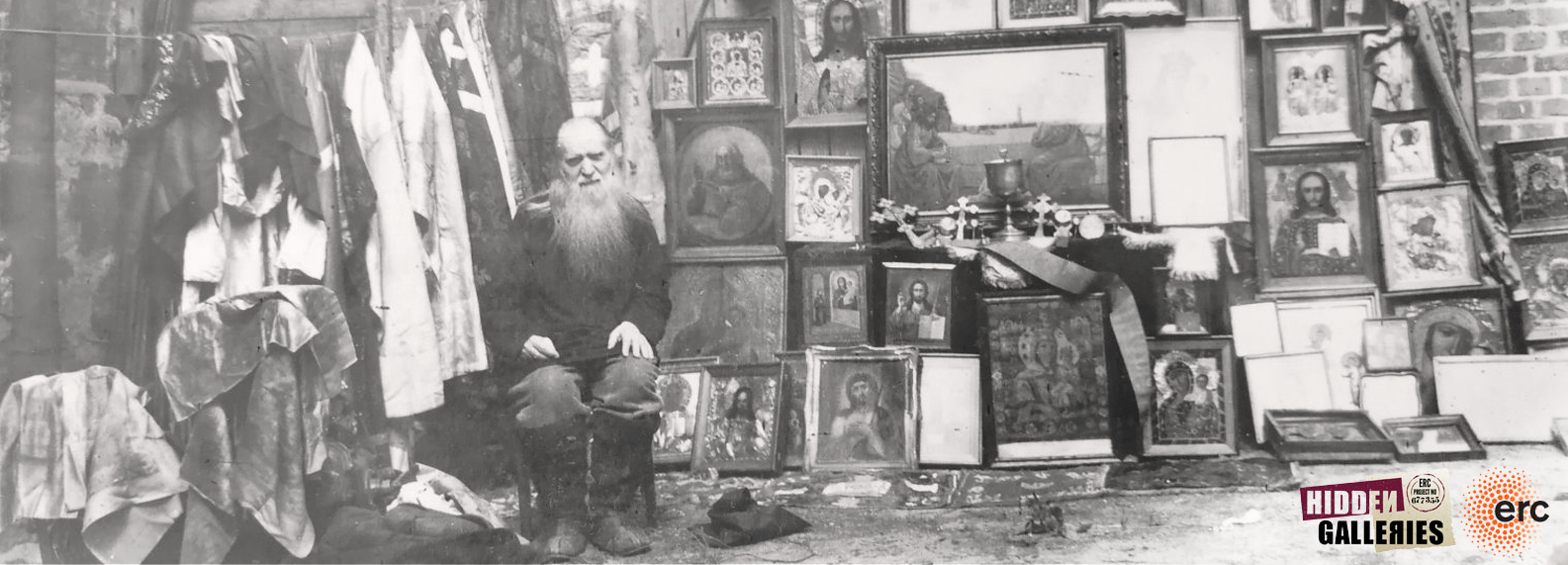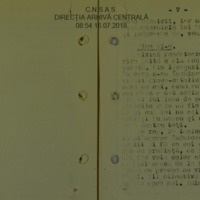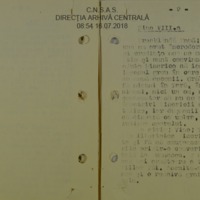Novena for the freedom of the Greek Catholic Church Romania
Item
Title
Novena for the freedom of the Greek Catholic Church Romania
Novena pentru libertatea Bisericii Greco-Catolice din România
Description
In the early 1970s, during a raid and house search on Fr. Aurel Leluțiu, the officers found amongst other documents a typed prayer entitled "Novena for the freedom of the Greek Catholic Church". The prayer, however, is not included in Fr Leluțiu’s file. The four images presented here are selections from the same ten-page Novena preserved in Bishop Ioan Dragomir’s secret police individual file. The prayer was considered problematic by the Securitate with mentions of it being made in several other files.
This Novena, a nine-day prayer exercise, is directed to the Virgin Mary to intermediate with Jesus on behalf of the Romanian Greek Catholics for the recognition and freedom of their church. It asks the Divinity to “not be late in breaking the chains of the Bishops, Priests and believers that remain faithful to the church.” Like several other memoranda and leaflets produced by the Greek Catholic underground in the late 1960s and 1970s, this prayer can be considered political in that it focused on tangible results in easing the life of the community under the political regime of the time. The prayer asked Virgin Mary to “Soften the hardened hearts of the state leaders […] so they would not fight the [church’s] activity and its resurrection from the underground where persecution has pushed us.”
Several tropes that characterize the life of the underground Greek Catholic Church can be noted in this prayer: church of the catacombs, the silent church, chains (breaking the/being in), erasing the memory of the church from the history of the nation. These themes run throughout the underground samizdat literature produced by the Greek Catholic intellectual and clerical elite.
The prayer was typed and it circulated extensively in Greek Catholic environments with mention of this prayer ranging from Bucharest to Brașov and Cluj-Napoca.
The four pages selected here from a ten-page manuscript, are part of CNSAS file I0003560, volume 3. Mentions about the manuscript are also found in CNSAS file I163305 volume 1. The manuscript is found at the back of the file alongside other samizdat materials.
This Novena, a nine-day prayer exercise, is directed to the Virgin Mary to intermediate with Jesus on behalf of the Romanian Greek Catholics for the recognition and freedom of their church. It asks the Divinity to “not be late in breaking the chains of the Bishops, Priests and believers that remain faithful to the church.” Like several other memoranda and leaflets produced by the Greek Catholic underground in the late 1960s and 1970s, this prayer can be considered political in that it focused on tangible results in easing the life of the community under the political regime of the time. The prayer asked Virgin Mary to “Soften the hardened hearts of the state leaders […] so they would not fight the [church’s] activity and its resurrection from the underground where persecution has pushed us.”
Several tropes that characterize the life of the underground Greek Catholic Church can be noted in this prayer: church of the catacombs, the silent church, chains (breaking the/being in), erasing the memory of the church from the history of the nation. These themes run throughout the underground samizdat literature produced by the Greek Catholic intellectual and clerical elite.
The prayer was typed and it circulated extensively in Greek Catholic environments with mention of this prayer ranging from Bucharest to Brașov and Cluj-Napoca.
The four pages selected here from a ten-page manuscript, are part of CNSAS file I0003560, volume 3. Mentions about the manuscript are also found in CNSAS file I163305 volume 1. The manuscript is found at the back of the file alongside other samizdat materials.
La începutul anilor '70, în timpul unui raid și a unei percheziții în casa preotului Aurel Leluţiu, ofițerii au găsit printre alte documente o rugăciune dactilografiată intitulată „Novenă pentru libertatea Bisericii Greco-Catolice”. Rugăciunea însă nu este inclusă în dosarul părintelui Leluțiu. Cele patru imagini prezentate aici sunt selecții din aceeași rugăciune, Novena, de zece pagini păstrate în dosarul individual al episcopului Ioan Dragomir întocmit de poliția secretă. Rugăciunea a fost considerată problematică de Securitate, ținând cont că aceasta a fost găsită în alte câteva dosare.
Această Novenă (o rugăciune de nouă zile) este îndreptată către Fecioara Maria pentru a intermedia către Isus în numele greco-catolicilor români pentru recunoașterea și libertatea bisericii lor. Se cere Divinității să „nu întârzie să spargă lanțurile episcopilor, preoților și credincioșilor care rămân fideli bisericii”. La fel ca alte câteva memorandumuri și pliante produse de clandestinitatea greco-catolică la sfârșitul anilor '60 și '70, această rugăciune poate fi considerată politică prin faptul că s-a concentrat pe rezultate tangibile, cerând facilitarea vieții comunității sub regimul politic al vremii. Rugăciunea a implorat-o pe Fecioara Maria să „înmoaie inimile împietrite ale conducătorilor statului [...] pentru ca aceștia să nu lupte împotriva activității [bisericii] și a învierii ei din clandestinitate, unde persecuția ne-a împins”.
Mai mulți tropi care caracterizează viața Bisericii Greco-Catolice în clandestinitate pot fi remarcate în această rugăciune: biserica catacombelor, biserica tăcută, lanțuri (ruperea/ a fi în), ștergerea memoriei bisericii din istoria națiunii. Aceste teme se desfășoară în întreaga literatură samizdat conspirativă produsă de elita intelectuală și clericală greco-catolică.
Rugăciunea a fost dactilografiată și a circulat pe scară largă în mediile greco-catolice, cu menționarea acestei rugăciuni, de la București la Brașov și Cluj-Napoca.
Cele patru pagini selectate aici dintr-un manuscris de zece pagini fac parte din dosarul CNSAS I0003560, volumul 3. Mențiunile despre manuscris se găsesc și în dosarul CNSAS I163305 volumul 1. Manuscrisul se găsește la sfârșitul dosarului alături de alte materiale samizdat.
Subject
Communism--Romania
Communism--Romania--History--20th century
Communism and religion
Catholic Church--Byzantine rite, Greek
Material culture--Religious aspects
Romania. Securitatea
Underground literature
Creator
Anca Sincan
Source
Consiliul Național pentru Studierea Arhivelor Securității (CNSAS) I0003560, volume 3
Consiliul Național pentru Studierea Arhivelor Securității (CNSAS) I163305 volume 1
Publisher
Date
1972-1973
Rights
This project has received funding from the European Research Council (ERC) under the European Union’s Horizon 2020 research and innovation programme No . 677355
Format
jpeg
Language
RO
Type
text
Identifier
CNSAS, I0003560, volume 3
CNSAS, I163305 volume 1
Coverage
20th century, Romania
Bibliographic Citation
Anca Sincan, "Novena for the freedom of the Greek Catholic Church"
Date Created
2019




